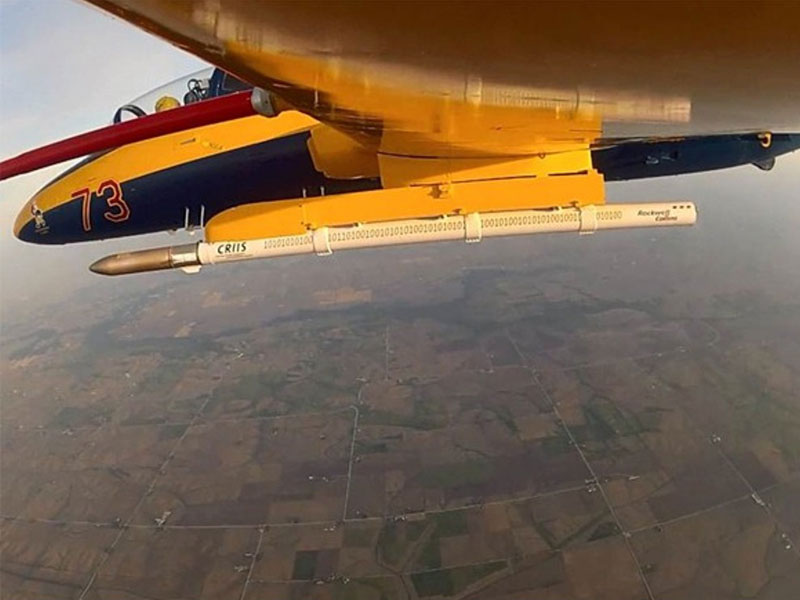Rockwell Collins Conducts CDR for CRIIS Program
01.04.2013 North America
Rockwell Collins has conducted a successful Critical Design Review (CDR) with the U.S. Air Force, and has been approved to begin the integration, test, and pre-production phase of the Common Range Integrated Instrumentation System (CRIIS) program.
Rockwell Collins is the prime contractor and systems integrator for the next-generation military test range system that will replace the Advanced Range Data System currently in use at major U.S. military test ranges. CRIIS will support weapon system testing for a variety of platforms, including advanced aircraft, and could also support testing of ships, helicopters, unmanned aerial vehicles and ground vehicles.
The program fulfills critical Department of Defense requirements to provide Time, Space, Position Information (TSPI), additional platform test data, and employs a more robust, spectrally efficient data link capable of multiple levels of encryption.
“Our design provides significant improvement in position accuracy and data link throughput while adding system-level security,” said Tommy Dodson, Vice President and General Manager of Surface Solutions for Rockwell Collins.
He added that the CRIIS program leverages the company’s strength in GPS, high throughput data links, Multiple Independent Levels of Security (MILS) encryption and open systems architecture.
“One key to the successful CDR was early system integration and performance testing using prototype hardware, providing insight not usually gained until much later in a program. This early system-level testing provided the customer with additional understanding of the maturity of the design,” Dodson added.
Customers attending the CDR also participated in technical demonstrations that highlighted the team’s progress on critical TSPI, data link, encryption, information assurance and system control functionality.
A CDR is conducted to determine that the detailed design satisfies the performance and engineering requirements of the development specification and to establish the detailed design compatibility between the item and other items of equipment, facilities, computer programs, and personnel. A CDR also serves to assess producibility and program risk areas and to review the preliminary product specifications.
Caption: Pictured is an engineering pod flown in the early development and testing phase of the Common Range Integrated Instrumentation System program. Rockwell Collins's design provides significant improvement in position accuracy and data link throughput while adding system-level security.
Rockwell Collins is the prime contractor and systems integrator for the next-generation military test range system that will replace the Advanced Range Data System currently in use at major U.S. military test ranges. CRIIS will support weapon system testing for a variety of platforms, including advanced aircraft, and could also support testing of ships, helicopters, unmanned aerial vehicles and ground vehicles.
The program fulfills critical Department of Defense requirements to provide Time, Space, Position Information (TSPI), additional platform test data, and employs a more robust, spectrally efficient data link capable of multiple levels of encryption.
“Our design provides significant improvement in position accuracy and data link throughput while adding system-level security,” said Tommy Dodson, Vice President and General Manager of Surface Solutions for Rockwell Collins.
He added that the CRIIS program leverages the company’s strength in GPS, high throughput data links, Multiple Independent Levels of Security (MILS) encryption and open systems architecture.
“One key to the successful CDR was early system integration and performance testing using prototype hardware, providing insight not usually gained until much later in a program. This early system-level testing provided the customer with additional understanding of the maturity of the design,” Dodson added.
Customers attending the CDR also participated in technical demonstrations that highlighted the team’s progress on critical TSPI, data link, encryption, information assurance and system control functionality.
A CDR is conducted to determine that the detailed design satisfies the performance and engineering requirements of the development specification and to establish the detailed design compatibility between the item and other items of equipment, facilities, computer programs, and personnel. A CDR also serves to assess producibility and program risk areas and to review the preliminary product specifications.
Caption: Pictured is an engineering pod flown in the early development and testing phase of the Common Range Integrated Instrumentation System program. Rockwell Collins's design provides significant improvement in position accuracy and data link throughput while adding system-level security.
Previous PostNGC’s AN/TPS-80 G/ATOR Radar Demos BMD Capability
Latest news
Latest events
DSEI 2025
09 - 12 Sep 2025Excel, London - United KingdomIntersec Saudi Arabia
29 Sep - 01 Oct 2025Riyadh International Exhibition & Convention Centre - Saudi ArabiaDubai International Air Chiefs’ Conference (DIACC 2025)
16 Nov 2025Atlantis, The Palm Dubai - United Arab EmiratesDubai Airshow
17 - 21 Nov 2025Dubai World Central (DWC) - United Arab Emirates






















